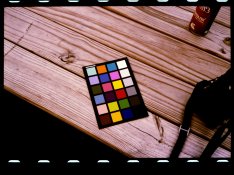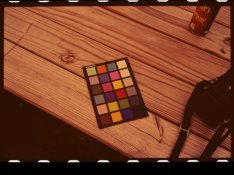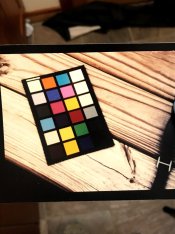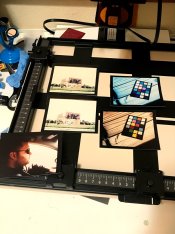grainyvision
Subscriber
So I tried RA-4 reversal today to see just how difficult the process appear to be.. Not difficult per se, but a ton of variables to tame to attempt to get a decent result. I tried exposure in 2 ways, under enlarger and exposed in a 120 camera (cut paper down to ~2x2" square) in daylight and tungsten. My initial mix was Dektol 1+2, (2 baths) vinegar based stop bath, and Kodak RA-4 chemicals, all at room temp. I confirmed this mix can get good whites as well as blacks. In-camera I first tried no filtration at 0.8 ISO and it was over exposed and nothing was rendered but cyan. Next tried adding a 60Y filter still at 0.8 ISO. Got a bit more highlight detail, but still nothing but cyan. I can only go up to ~110Y with my filters, and it was clear I needed to really cut a lot of blue... So I went the additive method. Just to give an idea of the relative exposure values. With 60Y I used a 2s exposure. With the lens stopped down by 1, I then used a 1/20 exposure, followed by a 1s green filter exposure, and 4s red filter exposure, using very pure and dark color filters I bought specifically for additive color printing. This resulted in somewhat reasonable colors, though a around a stop too much red. This is of course very cumbersome, but the colors that came out of it were promising. No mottling, good blacks and whites, no real technical problems other than I need to work on color balance a bit more. There's probably some crossing of green shadows into red, but that's not obvious until I can get proper color balance.
On that success, I did some research and came across a thread indicating that someone using Ilford PQ that was "aged" was able to create very accurate colors using something around 20M 50Y under an enlarger. I decided to "age" my mix by putting (into ~400ml) 2.6g of bromide and 1g of sea salt (didn't have any pure non-iodized). I then went back to subtractive filters for testing some enlarging. I ended up somewhere around 60Y and 20M which worked on a standard daylight slide. A darker sunset slide I used around 40Y and 10M. The results on the sunset slide were way too contrasty at first, so I put a "pinch' of sulide into the RA-4 developer. Next print looked great but didn't have great blacks, so I put in a splash more RA-4 developer. This gave me a slight decrease in contrast (though I still would've liked less) and restored the blacks. The sunset slide printed great and was quite true to the raw slide, though it lacked a little bit of red and green saturation and had more clipped shadows. The daylight slide still had some slight blueish-green cast, and it looked like there was some purple shadow color crossing. More importantly, at this point I finally experienced the fabled mottling of solid colors. This was after around 3 hours of test prints, and I only had ~400ml of all chemicals (5x7 trays doing 4x5 prints) so it's very possible this only showed up due to chemical exhaustion, or maybe a bit too much of one of the added chemicals. As a last and final test I took the filter stack for printing and used it for an in-camera exposure. I exposed again at 0.8 ISO (without metering through the filters) of a subject under tungsten lights. The result came out with a thick cyan cast with a slight green cast as well, but it did have some muted reds. The contrast was much more reasonable in-camera than under the enlarger, but the filter stick clearly needed a lot more yellow and a bit more magenta.
Overall I enjoyed the process (especially watching the colors come up in the RA-4 developer) and it was actually slightly easier per-print than normal RA-4 since there was only one tray to move between before I could use lights.
Anyway, it leaves me with a lot of questions though:
* Why does the paper react so differently under an enlarger compared to in-camera? It's significantly higher contrast, and requires a completely different filter stack. The in-camera test of this required a 45s exposure (~1 ISO paper indoors is hard) could the different layers have different reciprocity factors?
* Has anyone else tried this at room temp for all chemicals? I'm sure someone will say "it's not recommended" but I've gotten decent RA-4 prints out of it previously.. With RA-4 reversal I feel like most recommendations are out of the window anyway
* Is first developer in this to-completion? I didn't noticed a lot of difference varying between 1.5m and 3m other than slightly more clipped highlights.
* Has anyone tried this additive exposure method? According to previous research it is theoretically possible to get more color control and saturation through additive printing. Is this kind of control enough to overcome the wonky colors usual with RA-4 reversal? Also is there any reasonable way to meter for additive exposure? I feel like I'm basically just using ratios and guessing at the overall exposure needed
* Could flashing be used to help control the shadow color crossing? (very carefully of course to not ruin blacks)
* Is it normal to be lacking saturation? Is there some way to increase it in RA-4 reversal?
* How would alternative color developers work and produce interesting results? For instance C-41, E-6, or even ECN-2? Paper developers are typically very high activity, but it seems like RA-4 is less active than every other color developer.
* Is there any good way of taming the different color layer development? My understanding is the cyan layer is the "base" speed, magenta is 2x faster, and yellow is 4x faster. Ideally there would be some way of slowing down the fast layers.. I have a few ideas of things that exist as film developers, but no idea how they'd work on paper.
On that success, I did some research and came across a thread indicating that someone using Ilford PQ that was "aged" was able to create very accurate colors using something around 20M 50Y under an enlarger. I decided to "age" my mix by putting (into ~400ml) 2.6g of bromide and 1g of sea salt (didn't have any pure non-iodized). I then went back to subtractive filters for testing some enlarging. I ended up somewhere around 60Y and 20M which worked on a standard daylight slide. A darker sunset slide I used around 40Y and 10M. The results on the sunset slide were way too contrasty at first, so I put a "pinch' of sulide into the RA-4 developer. Next print looked great but didn't have great blacks, so I put in a splash more RA-4 developer. This gave me a slight decrease in contrast (though I still would've liked less) and restored the blacks. The sunset slide printed great and was quite true to the raw slide, though it lacked a little bit of red and green saturation and had more clipped shadows. The daylight slide still had some slight blueish-green cast, and it looked like there was some purple shadow color crossing. More importantly, at this point I finally experienced the fabled mottling of solid colors. This was after around 3 hours of test prints, and I only had ~400ml of all chemicals (5x7 trays doing 4x5 prints) so it's very possible this only showed up due to chemical exhaustion, or maybe a bit too much of one of the added chemicals. As a last and final test I took the filter stack for printing and used it for an in-camera exposure. I exposed again at 0.8 ISO (without metering through the filters) of a subject under tungsten lights. The result came out with a thick cyan cast with a slight green cast as well, but it did have some muted reds. The contrast was much more reasonable in-camera than under the enlarger, but the filter stick clearly needed a lot more yellow and a bit more magenta.
Overall I enjoyed the process (especially watching the colors come up in the RA-4 developer) and it was actually slightly easier per-print than normal RA-4 since there was only one tray to move between before I could use lights.
Anyway, it leaves me with a lot of questions though:
* Why does the paper react so differently under an enlarger compared to in-camera? It's significantly higher contrast, and requires a completely different filter stack. The in-camera test of this required a 45s exposure (~1 ISO paper indoors is hard) could the different layers have different reciprocity factors?
* Has anyone else tried this at room temp for all chemicals? I'm sure someone will say "it's not recommended" but I've gotten decent RA-4 prints out of it previously.. With RA-4 reversal I feel like most recommendations are out of the window anyway
* Is first developer in this to-completion? I didn't noticed a lot of difference varying between 1.5m and 3m other than slightly more clipped highlights.
* Has anyone tried this additive exposure method? According to previous research it is theoretically possible to get more color control and saturation through additive printing. Is this kind of control enough to overcome the wonky colors usual with RA-4 reversal? Also is there any reasonable way to meter for additive exposure? I feel like I'm basically just using ratios and guessing at the overall exposure needed
* Could flashing be used to help control the shadow color crossing? (very carefully of course to not ruin blacks)
* Is it normal to be lacking saturation? Is there some way to increase it in RA-4 reversal?
* How would alternative color developers work and produce interesting results? For instance C-41, E-6, or even ECN-2? Paper developers are typically very high activity, but it seems like RA-4 is less active than every other color developer.
* Is there any good way of taming the different color layer development? My understanding is the cyan layer is the "base" speed, magenta is 2x faster, and yellow is 4x faster. Ideally there would be some way of slowing down the fast layers.. I have a few ideas of things that exist as film developers, but no idea how they'd work on paper.














